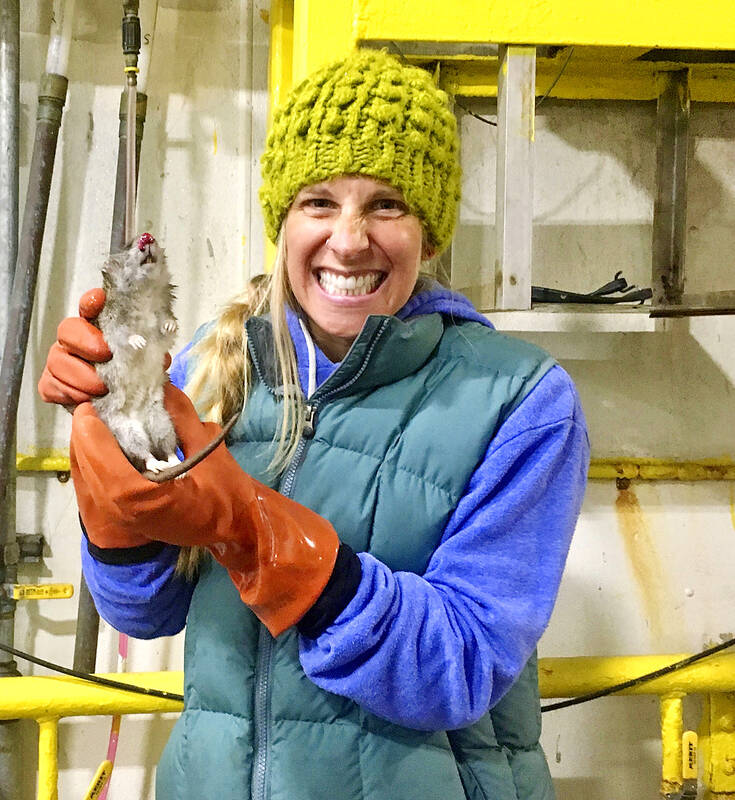On an island of windswept tundra in the Bering Sea, hundreds of miles from mainland Alaska, a resident sitting outside their home saw — well, did they see it? They were pretty sure they saw it — a rat.
The purported sighting would not have gotten attention in many places around the world, but it caused a stir on Saint Paul Island, which is part of the Pribilof Islands, a birding haven sometimes called the “Galapagos of the north” for its diversity of life.
That is because rats that stow away on vessels can quickly populate and overrun remote islands, devastating bird populations by eating eggs, chicks or even adults and upending once-vibrant ecosystems.

Photo: Aleut Community of Saint Paul Island via AP
Shortly after receiving the resident’s report in June, wildlife officials arrived at the apartment complex and crawled through nearby grasses, around the building and under the porch, looking for tracks, chew marks or droppings.
They baited traps with peanut butter and set up trail cameras to capture any confirmation of the rat’s existence — but so far have found no evidence.
“We know — because we’ve seen this on other islands and in other locations in Alaska and across the world — that rats absolutely decimate seabird colonies, so the threat is never one that the community would take lightly,” said Lauren Divine, director of the Ecosystem Conservation Office at the Aleut Community of Saint Paul Island.
The anxiety on the island is the latest development amid longstanding efforts to get or keep non-native rats off some of the most remote, but ecologically diverse, islands in Alaska and around the world.
Rodents have been removed from hundreds of islands worldwide — including one in Alaska’s Aleutian chain formerly known as “Rat Island,” the US Fish and Wildlife Service said.
However, such efforts can take years and cost millions of dollars, so prevention is considered the best defense.
Around the developed areas of Saint Paul, officials have set out blocks of wax — “chew blocks” — designed to record any telltale incisor bites. Some of the blocks are made with ultraviolet material, which allows inspectors armed with black lights to search for glowing droppings.
They also have asked residents to be on the lookout for any rodents and are seeking permission to have the US Department of Agriculture bring a dog to the island to sniff out any rats.
Canines are otherwise banned from the Pribilofs to protect fur seals.
No traces of any rats have been found since the reported sighting this summer, but the hunt and heightened state of vigilance is likely to persist for months.
Divine likened the search to trying to find a needle in a haystack “and not knowing if a needle even exists.”
The community of about 350 people — clustered on the southern tip of a treeless island marked by rolling hills, rimmed by cliffs and battered by storms — has long had a rodent surveillance program that includes rat traps near the airport and at developed waterfront areas where vessels arrive, designed to detect or kill any rats that might show up.
Still, it took nearly a year to catch the last known rat on Saint Paul, which was believed to have hopped off a barge. It was found dead in 2019 after it evaded the community’s initial defenses.
That underscores why even an unsubstantiated sighting is taken so seriously, Divine said.
The US Fish and Wildlife Service is planning an environmental review to analyze eradicating the potentially tens of thousands of rats on four uninhabited islands in the far-flung, volcano-pocked Aleutian chain, hundreds of miles southwest of Saint Paul.
More than 10 million seabirds of varying species nest in the Aleutians.
Donald Lyons, director of conservation science at the National Audubon Society’s Seabird Institute, described being in the Pribilof Islands and watching clouds of auklets return to their colonies in the evening — “tens of thousands, hundreds of thousands, perhaps millions of birds in the air at a given time.”
He said officials were right to take the alleged sighting of a rat on Saint Paul so seriously.
He credited the largely Alaska Native communities in the Pribilofs for their efforts to keep invasive species out.
“It’s just the abundance of wildlife that we hear stories or read historical accounts of, but really seldom see in kind of our modern age,” he said. “And so it really is a place where I’ve felt the wonder, the spectacle of nature.”

When Shanghai-based designer Guo Qingshan posted a vacation photo on Valentine’s Day and captioned it “Puppy Mountain,” it became a sensation in China and even created a tourist destination. Guo had gone on a hike while visiting his hometown of Yichang in central China’s Hubei Province late last month. When reviewing the photographs, he saw something he had not noticed before: A mountain shaped like a dog’s head rested on the ground next to the Yangtze River, its snout perched at the water’s edge. “It was so magical and cute. I was so excited and happy when I discovered it,” Guo said.

Chinese authorities said they began live-fire exercises in the Gulf of Tonkin on Monday, only days after Vietnam announced a new line marking what it considers its territory in the body of water between the nations. The Chinese Maritime Safety Administration said the exercises would be focused on the Beibu Gulf area, closer to the Chinese side of the Gulf of Tonkin, and would run until tomorrow evening. It gave no further details, but the drills follow an announcement last week by Vietnam establishing a baseline used to calculate the width of its territorial waters in the Gulf of Tonkin. State-run Vietnam News

TURNAROUND: The Liberal Party had trailed the Conservatives by a wide margin, but that was before Trump threatened to make Canada the US’ 51st state Canada’s ruling Liberals, who a few weeks ago looked certain to lose an election this year, are mounting a major comeback amid the threat of US tariffs and are tied with their rival Conservatives, according to three new polls. An Ipsos survey released late on Tuesday showed that the left-leaning Liberals have 38 percent public support and the official opposition center-right Conservatives have 36 percent. The Liberals have overturned a 26-point deficit in six weeks, and run advertisements comparing the Conservative leader to Trump. The Conservative strategy had long been to attack unpopular Canadian Prime Minister Justin Trudeau, but last month he

Four decades after they were forced apart, US-raised Adamary Garcia and her birth mother on Saturday fell into each other’s arms at the airport in Santiago, Chile. Without speaking, they embraced tearfully: A rare reunification for one the thousands of Chileans taken from their mothers as babies and given up for adoption abroad. “The worst is over,” Edita Bizama, 64, said as she beheld her daughter for the first time since her birth 41 years ago. Garcia had flown to Santiago with four other women born in Chile and adopted in the US. Reports have estimated there were 20,000 such cases from 1950 to